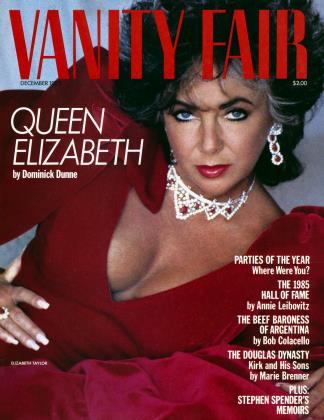Sign In to Your Account
Subscribers have complete access to the archive.
Sign In Not a Subscriber?Join NowARCHITECTURE
Towering Achievements
Douglas Davis
In the midst of a decade devoted to postmodern revivalism in architecture, to the ostentatious display of honeyed conceits borrowed from the past—whether a classical arch or a neoclassical column—two immense contradictions are rising to defy this trend. One of them, the Hongkong Bank headquarters in Hong Kong, is completed, though its formal opening will not occur until next year. The other, the new headquarters of the fabled Lloyd's of London, nestled in the heart of the old financial "City," is almost finished, aiming for a spring opening, but already attracting astonished stares and an incredulous press.
Faced with the symbolic importance of rearing a "headquarters" image, neither institution spared expense: the Lloyd's building cost more than $200 million, the Hongkong Bank three times that. The gleaming, polished Hongkong Bank looks like nothing so much as a rocket ship ready for the launch. Lloyd's of London, encircled by six towers jammed with elevators, ducts, and fire escapes, rises to a height of fourteen stories, but its central glass-covered atrium betrays the surprising truth: it is an empty shell. Its core is a single "room" that boasts a 240-foot ceiling, one of the highest in the world.
Who dared to design these buildings in this manner? Space-age Americans, weaned on NASA, or young Japanese designers, inspired by electronic razzle-dazzle? No, the aesthetic, the lineage, the names are British to the core: Norman Foster, fifty, is the Svengali behind the Hongkong Bank, Richard Rogers, fiftytwo, the craftsman of Lloyd's.
When Rogers and Foster talk about their goals they sound like poets, not mechanics: "Architecture," Rogers often says, "is about glorifying building." Foster, who flies airplanes as a hobby, likes to cite the glider as his inspiration in designing architecture, because it combines "beauty. . . comfort ... low energy... high technology."
In an ancient, tradition-bound country struggling to catch up to more advanced hightech societies, they are anomalies. Further, they are not among the names currently celebrated on American or European campuses or in the architectural press. Indeed, the reverse is the case. Since the decisive shift in the seventies away from any style, motif, or material associated with the despised "modem" movement—or, worse, with the contemporary world—they have been unofficially banished. Rogers, who collaborated with Renzo Piano of Italy to produce the controversial and gregarious Centre Pompidou in Paris—a museum that resembles a futuristic oil refinery— has been shunned by the elite since the late seventies. Foster has not suffered quite the same slings and arrows for his streamlined, precision-fit office buildings, factories, and art galleries. The design for the Hongkong Bank was displayed in 1983 at the Museum of Modem Art in New York, along with new skyscrapers by Philip Johnson and Skidmore, Owings & Merrill, which meant that Foster was ready to compete on the big stage.
At a moment when architecture critics clog their columns with references to Lutyens, Palladio, and Borromini, it is impossible to fit either Foster's or Rogers's buildings into the nostalgic jargon of the moment. Save for the barrel-vaulted glass roof that spans Lloyd's atrium, there isn't a single historical or figurative reference anywhere in either structure (the barrel vault is as old as ancient Rome). Metaphorical flourish has been rejected. At first glance, this is an architecture that stands only for itself.
Yet these gorgeous buildings have as little to do with the no-nonsense functionalism associated (often inaccurately) with the early modem movement as they do with neoclassical London or postmodern New York. They are as gaudy, as mannered as the all-glass Crystal Palace erected in Victorian London or the pink granite AT&T building on Madison Avenue. Surely this high-tech romanticism is an ironic consequence of British life—a society committed to yesterday, where modernity is tempting, exotic fruit.
In this dense decade, when one huge monolithic tower after another rushes toward the sky, straining to pretend that it belongs to another, remote era, Hongkong and Lloyd's stand separate from the pack. They are clearly stamped with the impress of this moment as unmistakably as the surrounding buildings are not. They admit their youth, and by defying history have made it.
 View Full Issue
View Full Issue












Subscribers have complete access to the archive.
Sign In Not a Subscriber?Join Now